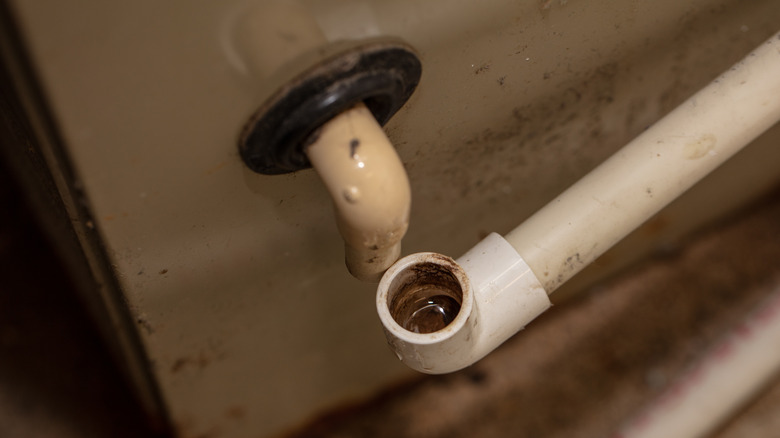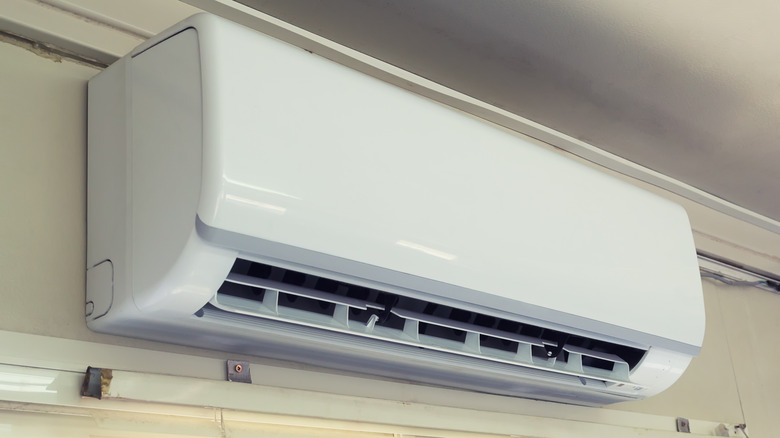The Quick Cleaning Fix For A Musty Air Conditioner
A musty-smelling air conditioner gives new meaning to the phrase "cold comfort." As wonderful as it can be to escape the stifling heat, your pleasure can abruptly end if your room smells like a moldy basement. But take heart, because the most common cause of a musty air conditioner requires a simple fix. The only specialized tool you need might already be in your kitchen: an ordinary turkey baster. This little wonder is designed to help you move liquid when you can't move the container itself, and that makes it suitable for a lot more than keeping your turkey moist.
Liquid is ultimately the cause of most musty smells. Having too much water in the wrong place is how you end up with mold growing in unexpected or unfortunate places. Mold growth is what most people are describing when they talk about "musty" smells. In the case of a window air conditioner or a ductless air conditioner like a mini split, mold growth often starts in the parts of the AC designed to drain condensation away from the unit. The same applies to even the best portable air conditioners. These drains are prone to clogging, which can cause them to overflow in the wrong places and, almost always, to promote the growth of moisture-loving mold and mildew. Most window units are designed to drain pooled condensation away through a small hose attached to the AC, and that's where the problem usually lies.
Emptying the drain pan with a turkey baster
If your AC's drain pan (which is often simply the bottom of the AC's housing) doesn't empty properly through the hose, water will collect there until it finds another way out. This way is usually to the ground below or, in the case of a mini split, running down your walls. And the resulting mold growth is practically inevitable. This can happen because the drain line was improperly installed (or not installed at all), or because there's a clog somewhere in the drain system. Dealing with the problem is a two-step process of emptying the drain pan and clearing whatever obstruction is causing the backup. To avoid spilling water everywhere, start by emptying the drain pan.
Here's where the turkey baster comes in. Since you're probably not going to lift up the AC to pour off the water, you'll need to get it out of there some other way, and a baster is perfect for pulling off sizable amounts of water. Suck it up, squeeze it out, repeat. Open the AC unit so that you can reach the standing water with your baster. Typically, this involves removing the front of a window unit, which usually unclips easily, and perhaps removing the air filters within. The steps vary by AC style (window unit, portable, or mini split) and by model, so consult your user manual for details. While you're at it, giving the air conditioner a good cleaning will help eliminate other sources of odors.
Clearing the drain line
Now you have to deal with the reason it was full in the first place — usually, a clogged drain hole or tube. As air blows through the air conditioner, it collects in the condensation. Over time, the dirt builds up and you eventually have a clog in the narrow drain hose. Sometimes you can push the clog out with a wire hanger, skewer, etc. But drain tubes tend to travel farther than these implements can reach, in which case you'll need some pressure in the line to push the obstruction out. Since turkey basters work in both directions, you can use one to effectively blow out most clogs. And you'll want to flush any lingering debris from the tube even if the hanger approach works.
To do this, you'll need to remove the drain tube. Pull the hose, twisting it slightly if necessary. It will eventually be released from the barbed connection to the drain pan. Suck some clean water up into the baster. You can then push the narrow opening of the baster into the tube until it forms a seal with the tube. Hold the two firmly together and give the baster's bulb a good squeeze. The force of the baster blast will be enough to push most clogs out, or at least further down the drain line. Keep flushing in this fashion until your clog pops out the end of the tube, then reattach the drain line to the AC unit.


